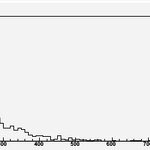Mathematics
Much like a superconductor loses no energy to resistance, a superfluid moves like a completely frictionless liquid, able to propel itself without any hindrance from gravity or surface tension.
The physics underlying these materials, which appear to defy the common sense precepts of conventional physics, has been a source of fascination for decades.
Liquid helium is an example. When cooled to extremely low temperatures, helium exhibits behavior that is otherwise impossible in ordinary fluid - the superfluid can squeeze through pores as small as a molecule, and climb up and over the…

University of California - Davis biochemists have shown for the first time that the ergodic theorem can be demonstrated by a collection of individual protein molecules; specifically, a protein that unwinds DNA.
The ergodic theorem, proposed by mathematician George Birkhoff in 1931, holds that if you follow an individual particle over an infinite amount of time, it will go through all the states that are seen in an infinite population at an instant in time. It's a fundamental assumption in statistical mechanics -- but difficult to prove in an experiment.
Using technology invented at UC Davis…
Game theory is used today in a wide range of areas such as economics, social sciences, biology and philosophy, gives a mathematical framework for describing a situation of conflict or cooperation between intelligent rational players.
The central goal is to predict the outcome of the process. In the early 1950s, John Nash showed that the strategies adopted by the players form an equilibrium point (so-called Nash equilibrium) for which none of the players has any incentive to change strategy.
Quantum mechanics describes the physics of small objects such as particles and atoms and…

Using the same kind of mathematical formulas used to draw political redistricting maps, Johns Hopkins researchers say they have developed a model that would allow for the more equitable allocation of livers from deceased donors for transplantation.
They claim that where you live dictates the availability of a liver transplant - geography can mean the difference between a 10 percent chance of dying while on the waiting list for a donor liver, and a 90 percent chance.
Their new model ignores the longstanding relationships among medical centers used to create the current unbalanced system and…

Cities have long been likened to organisms, ant colonies, and river networks. Yet clever analogies fail to capture the essence of how cities really function.
A paper in Science attempts to derive a series of mathematical formulas that describe how cities' properties vary in relation to their population size, and then posits a unified, quantitative framework for understanding how cities function and grow. The resulting theoretical framework predicts dozens of statistical relationships observed in thousands of real cities around the world for which reliable data are available.
Models…

A 350-year-old mathematical mystery, that two pendulum clocks mounted together could swing in opposite directions, due to tiny vibrations in the beam caused by both clocks affecting their motions, is a step closing to having a formula derived.
And it could lead to a better understanding of medical conditions like epilepsy or even the behavior of predator-prey systems in the wild, University of Pittsburgh researchers report.
The "indirect coupling" effect mystery dates back to 1665, when Dutch mathematician, astronomer and physicist Christiaan Huygens, inventor of the pendulum…

This describes the maths behind the sloth canon number sequences described in my Self Similar Sloth Canon Number Sequences article
It simplifies the proofs here to use a 0 based notation. So we define an integer sequence f(n) as a map from the non negative integers to the integers. The first term in the sequence is f(0).
Sloth Canon Sequences
Definition of a sloth canon sequence
A sloth canon sequence is an integer sequence f(n) (mapping from positive integers to the integers) with similarity repeat interval r satisfying the functional equation:
f(n*r) = f(n).
Let's call this the sloth…

The Danish composer Per Nørgård uses an endless self similar (fractal like) strict sloth canon structure in some of his compositions such as his Symphony number 2. He first discovered his sequence in 1959.
I came across the idea of a sloth canon number sequence independently, as a mathematician, when I wondered if there is any way to use the Koch Snowflake fractal construction in music. Here it is, starts with a star, adds smaller and smaller triangles to the sides to get the snowflake shape:
I wrote the Tune Smithy program to explore the same sort of construction in music.…

Terror networks are comparable in their structure to hierarchical organization in companies and certain online social networks, say the authors of a paper outlining how
a mathematical model to disrupt flow of information in a complex real-world network, like a terrorist organization, can work, using minimal resources.
In those hierarchical social networks, information flows in one direction from a source, which produces the information or data, downwards to sinks, which consume it.
"In such networks, the flow of information is often one way," explains author Pawel Pralat. "For…

Two days ago I wrote a quick post to stimulate non-flat-EEG readers to consider an apparently trivial question, which in fact hid many subtleties. The general question I wanted to address was whether an estimate missing an uncertainty was more or less useful than a quoted uncertainty on the same parameter when the estimate itself was missing.
The educational purpose of this question is evident: everywhere, except in scientific publications, we see numbers quoted without an assessment of their uncertainty; this is a widespread practice which "lowers the bar" of the provided information, and…